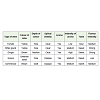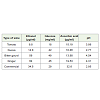Research Article
Production of Homemade Wine Using Different Plant Substrates
Shashikanth Vale, Sumanth Deekonda, Sravani P, Sahiti Mannar TB and Sushma Patkar*
Bhavan’s Vivekananda College of Sciences, Humanities and Commerce, Sainikpuri, Hyderabad, India
Corresponding author: Sushma Patkar, Bhavan’s Vivekananda College of Sciences, Humanities and Commerce,Sainikpuri, Hyderabad, India, Phone: 040-2711611, Fax 040-27112717; E-mail: sushma.ghosh@gmail.com;evershineshashi@gmail.com
Citation: Shashikanth V, Sumanth D, Sravani P, Sahiti Mannar TB, Sushma P. Production of Homemade Wine Using Different Plant Substrates. Indian02 J Nutri. 2016;3(2): 139.
Copyright © 2016 Shashikanth. This is an open access article distributed under the Creative Commons Attribution License, which permits unrestricted use, distribution, and reproduction in any medium, provided the original work is properly cited.
Indian Journal of Nutrition | ISSN: 2395-2326 | Volume: 3, Issue: 2
Submission: 19/08/2016; Accepted: 06/09/2016; Published: 10/09/2016
Abstract
Home wine making is an educative and enjoyable hobby. Wine can be made from any non toxic part of plant. In the present study, wine was prepared from tomato, guava, bitter guard and ginger. Ethanol, Ascorbic acid and glucose content were measured in respective wine samples and were compared with commercially available wine. Tomato (9.8 μg/ml) and Guava (14.8 μg/ml) wines had the lower ethanol content when compared to bitter gourd (59 μg/ml), ginger(64 μg/ml) and commercial wine (34.5 μg/ml). Glucose content was found to be lower in tomato wine (18 mg/ml) than commercial (29 mg/ml), however guava(42 mg/ml), bitter gourd (49 mg/ml), and ginger wine (45 mg/ml) had higher glucose content than commercial wine. Ginger (19.53 μg/ml) and tomato (15.19μg/ml) wines had high ascorbic acid concentration as compared to guava (10.86 μg/ml) and bitter gourd (13.88 μg/ml), however the ascorbic acid content was highest in commercial wine ( 32.6μg/ml). Homemade tomato and guava wine were found to have lower ethanol content and tomato wine had lower glucosecontent than commercial wine.
Keywords: Homemade wine; Plant substrates and Ethanol
Introduction
Wine is an alcoholic drink prepared by fermentation. Homewinemaking can be both educative and enjoyable. Traditional homemade wine recepies use grapes as base ingredient as it containsthe correct mix of sugar, moisture and nutrients required for fermentation. Wine can be made from almost any non-toxic plant or plant part if additional ingredients are supplied in correct proportion. Wine has been prepared by using fruits like apple or berries [1], Tomato [2], Jamun [3], plum [4] or from mixed fruit juices likepineapple and orange [5] or fruit juices with betel leaf [6] or usingIndian Gooseberry [7] and spices like Ginger [7]. Research indicatesthat if taken in moderate doses, wine intake affects cholesterol levelsfavorably, decreasing the tendency of blood to clot and assists indissolving clots thereby protecting from cardiovascular disease. Winecontains quercetin a potent anti carcinogen, and many flavnoids andpolyphenolic antioxidants. Studies have indicated moderate intake of wine delays dementia and prevents arthiritis [8]. The objective of thepresent study is to prepare wine using fruits like Tomato, Bitter guard,Guava and rhizome like ginger, estimate the ethanol, glucose contentand ascorbic acid concentration and compare these parameters withcommercial wine. The mentioned plant substrates were taken owingto their easy availability, health benefits, antioxidant, nutritional andmedicinal properties.
Methodology
Ripe tomato, guava, bitter gourd and ginger (1Kg each) werepurchased from the local market, washed thoroughly in tap water andwere cut in small pieces. Tomato pieces were ground in a mixer and thepulp was strained through a muslin cloth, whereas juice from guava,bitter gourd and ginger was extracted with water and was filtered.The extracts were dispensed in conical flasks, autoclaved, inoculatedwith Baker’s yeast (Saccharomyces cerevisiae) and fermented for two months. The wine obtained was filtered and evaluated for sensoryparameters by volunteers recruited from our Institution. Evaluationof pH was done using a pH meter (ELICO digital pH meter). Ethanolby Potassium di chromate method [9], Glucose by DNS method(Dinitrosalicylic) [10] and Ascorbic acid content [11] were analyzedin respective wine samples and compared.
Results
Table 1 summarizes the sensory parameters of wine from differentsources. All the wines were found to be aromatic, with ginger wineshowing high intensity of aroma. With respect to color all wines werepale except ginger. Bitter gourd and ginger wine showed strong flavorintensity. Except tomato other wines were sweet to taste. pH, ethanol,glucose and ascorbic acid content are summarized in Table 2. ThepH of Tomato wine is 3.86, Bitter gourd wine is 4.04, Guava wineis 2.77, Ginger wine 4.31 and commercial wine is 2.95. Guava winewas more acidic than other wines. Tomato (9.8 μg/ml) and Guava(14.8 μg/ml) wines had the lower ethanol content when comparedto bitter gourd (59 μg/ml), ginger (64 μg/ml) and commercial wine(34.5 μg/ml). Glucose content was found to be lower in tomato wine(18 mg/ml) than commercial (29 mg/ml), however guava (42 mg/ml), bitter gourd (49 mg/ml), and ginger wine (45 mg/ml) had higherglucose content than commercial wine. Ginger (19.53 μg/ml) and tomato (15.19 μg/ml) wines had high ascorbic acid concentrationas compared to guava (10.86 μg/ml) and bitter gourd (13.88 μg/ml),however the ascorbic acid content was highest in commercial wine (32.6μg/ml).
Conclusion
The study mainly focused on preparing homemade wine andexperimental investigation was aimed at studying the variation ofpH, ethanol, glucose and ascorbic acid content in homemade andcommercially available wine. Homemade tomato and guava winewere found to have lower ethanol content and tomato wine had lowerglucose content than commercial wine. These homemade wines wereprepared without added preservatives and additives, therefore theyare not harmful for health and can be taken daily in moderation.Further analysis and processing may take the study a step closer toproduction on industrial scale.
References
- Berry CJJ (2000) First steps in wine making. Published by G.W. Kent, Inc. 3667 Morgan Road, Ann Arbor M I 48108, 235.
- Many JN, Radhika B, Ganeshan T (2014) Study on Tomato wine production and optimization. Journal of Environmental Science, Toxicology and Food Technology 8: 97-100.
- Chowdhury P, Ray RC (2007) Fermentation of Jamun (Syzgium cumini L) fruits to form red wine. ASEAN food journal 14: 15-32.
- Miljic UD, Puskas VS (2014) Influence of fermentation conditions on production of plum (Prunus domestica L.) wine: A response surface methodology approach. Hem Ind 68: 199-206.
- Archibong EJ, Ezemba CC, Chukwujama IC, Archibong UE (2015) Production of wine from mixed fruits: Pineapple (Anans cosmosus) and orange (Citrus sinensis) using yeast isolated from palm wine. World J of Pharmacy and Pharmaceutical Sciences 4: 126-136.
- Lata S, Mishra T, Kumari A (2014) Wine preparation from different fruit substrates. Int Res J Biological Sciences 3: 61-67.
- Nandagopal GMS, Nair P (2013) Production of wine from Ginger and Indian Gooseberry and a comparative study of them over commercial wine. American Journal of Engineering Research 3: 19-38.
- Robinson J (ed, 2006) The Oxford Companion to wine†Third Edition, Pg 341-342. Oxford University Press.
- http://shodhganga.inflibnet.ac.in/
- Miller GL (1959) Use of dinitrosalicylic acid reagent for determination of reducing sugar. Anal Chem 31: 426-428.
- Rao BS, Deshpande V (2005) Experimental Biochemistry- A student companion, I.K International Pvt. Ltd.


